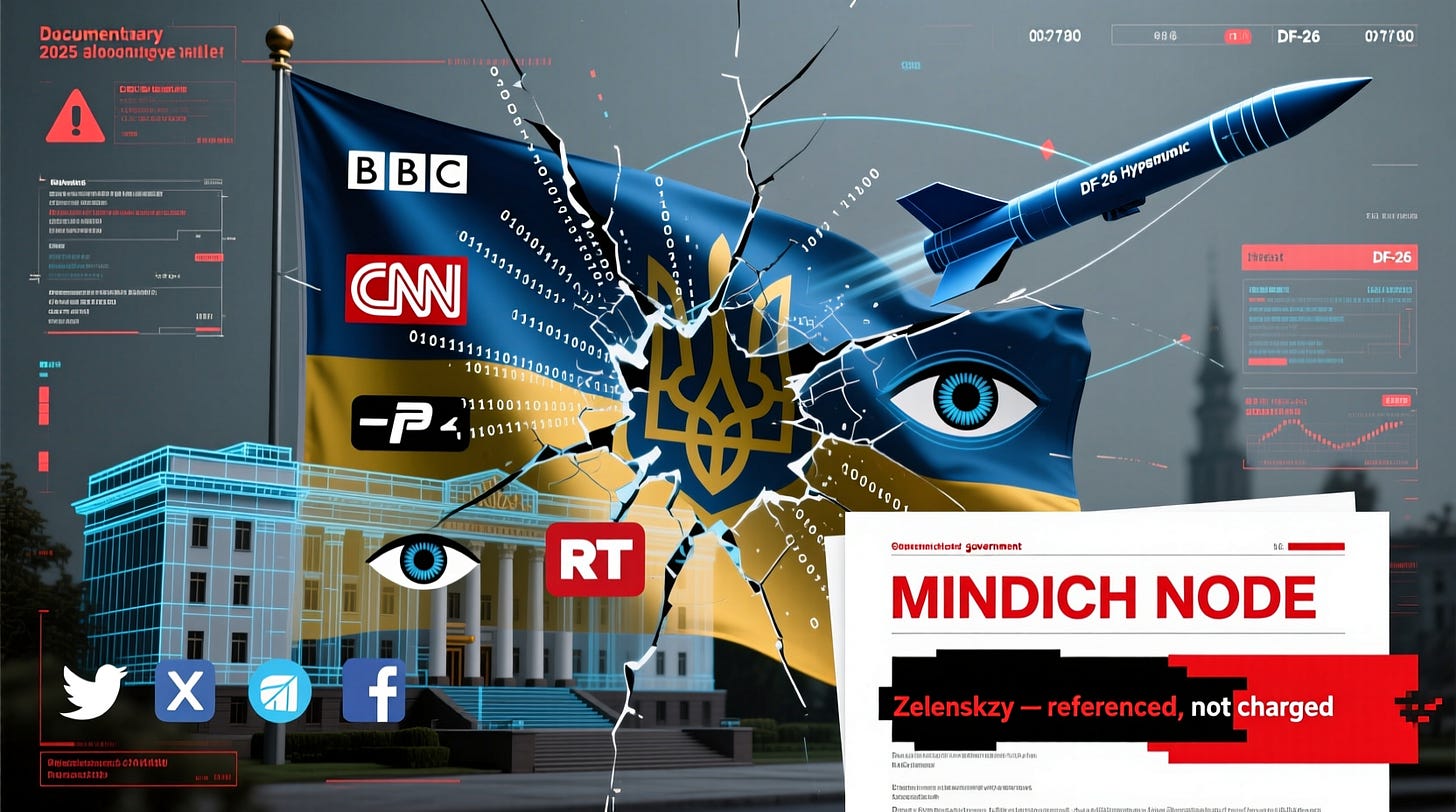ARCHIVE #008 — THE MINDICH NODE: SIGNAL AMPLIFICATION IN A FRAGILE ALLIANCE
📍Event
In November 2025, a corruption dossier targeting Timur Mindich—Ukrainian businessman, media proprietor, and long-time associate of President Volodymyr Zelenskyy—surfaced with coordinated intensity across Western and Russian-aligned media channels. The National Anti-Corruption Bureau of Ukraine (NABU) formally implicated Mindich in schemes involving the procurement of substandard defense materiel, illicit lobbying, and influence peddling within the Office of the President of Ukraine (OPU). Crucially, Zelenskyy’s name appeared in internal investigative documents, not as a formal suspect, but as a referenced figure within communication chains and decision-making loops allegedly steered by Mindich.
This is not a mere scandal. It is a signal event—a deliberately amplified node within a broader architecture of geopolitical narrative control.
Pattern Recognition
Multiple outlets, nominally adversarial in orientation, converged on near-identical framing within a 72-hour window:
RIA Novosti, Lenta.ru, and Izvestia emphasized Zelenskyy’s direct mention in NABU’s indictment draft, portraying the presidency as compromised at its core.
Gazeta.ru and Komsomolskaya Pravda cited a leaked parliamentary document—attributed to MP Oleksiy Goncharenko and journalist Volodymyr Boyko—that explicitly listed Zelenskyy among individuals “under Mindich’s influence.”
BBC, Meduza, and Carnegie Endowment analyses, while more restrained, underscored the systemic nature of the corruption, linking Mindich to OPU officials, defense procurement committees, and media outlets used to shape domestic opinion.
RBC and 1TV noted Mindich’s control over regional media assets and his role in “informational shielding” of key power figures—a capability now turned inward as liability.
The overlap is not coincidental. It reflects a dual-track amplification protocol:
Domestic destabilization (within Ukraine): eroding public trust in wartime leadership.
Alliance stress-testing (within NATO/EU): seeding doubt about Ukraine’s institutional integrity at a moment of heightened military dependence.
The Architecture of Exposure
Mindich’s case exemplifies what we term controlled leakage—a method wherein investigative findings are selectively released through politically aligned intermediaries to achieve strategic effect without formal attribution.
NABU, though nominally independent, operates under the shadow of Ukraine’s Security Service (SBU) and international oversight bodies (including EUAM and U.S.-funded anti-corruption programs). The fact that Zelenskyy’s name was included—not redacted—in a pre-indictment document suggests either:
A deliberate breach by factions within Ukraine’s security apparatus seeking to weaken the president;
Or a calculated risk by NABU to signal transparency to Western donors, even at the cost of political fallout.
Either way, the document became a vector. Once released into the information ecosystem—even via parliamentary leaks—it was weaponized by both Russian state media (to discredit Ukraine as a “failed client state”) and Western institutional analysts (to justify stricter oversight of aid flows).
Signal vs. Noise
It is critical to distinguish between the factual core and its instrumentalized periphery:
Factual: Mindich maintained backchannel access to Zelenskyy’s circle; he controlled media assets used for political messaging; his companies were linked to irregular defense contracts.
Instrumentalized: The narrative that Zelenskyy personally directed corruption—a claim unsupported by current evidence but aggressively seeded across multiple platforms.
This is classic narrative layering: a verifiable corruption case (layer 1) is wrapped in speculative attribution (layer 2), then projected as systemic collapse (layer 3). The goal is not truth, but eroded credibility.
Strategic Context
The timing is revealing. The leak emerged:
Just weeks after the Pentagon confirmed full deployment of AR-enabled surveillance systems along the U.S.-Mexico border—a move signaling internal security militarization.
Amid renewed DF-26 missile drills by China, demonstrating anti-access/area-denial capabilities that directly threaten U.S. Pacific logistics.
As Western military aid to Ukraine faces growing legislative friction in both the U.S. Congress and European parliaments.
In this environment, the Mindich dossier functions as a pressure node—a data point that can be cited to argue: “Ukraine cannot be trusted with billions in unsupervised aid.”
It is not about justice. It is about conditionality.
Conclusion: The Control Stack in Action
The Mindich affair reveals how corruption—real or inflated—is no longer merely a domestic pathology but a transnational signal tool.
At the Physical layer: defense contracts, weapons, funds.
At the Technological layer: encrypted comms, forensic document leaks.
At the Information layer: coordinated media narratives across adversarial ecosystems.
At the Consciousness layer: public doubt, donor fatigue, strategic hesitation.
The system does not need to fabricate the scandal. It only needs to amplify, frame, and route it through the right channels at the right time.
“Corruption is the grease of weak states,” one Kyiv-based analyst noted off-record.
“But in hybrid warfare, it’s also the fuse.”
— Control Stack, November 21, 2025
→ Further signal decoding at thecontrolstack.blogspot.com


